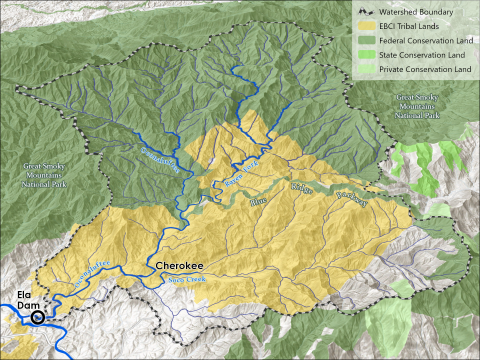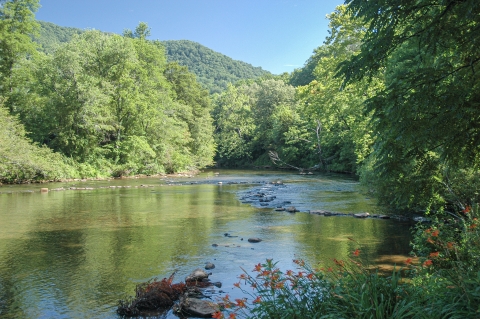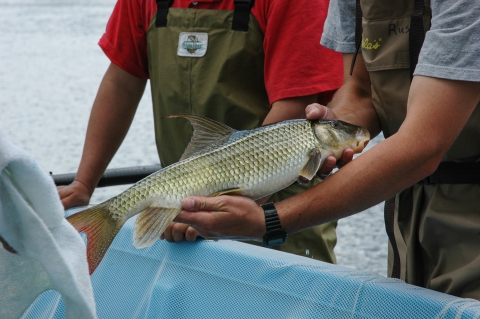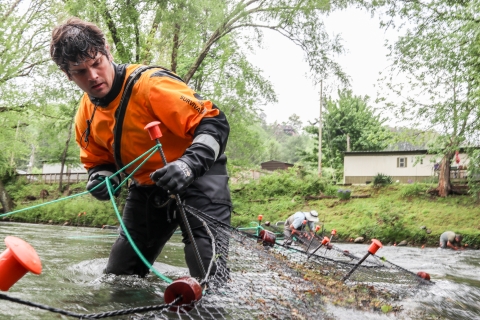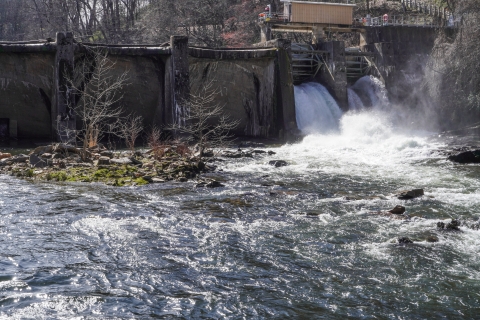States
North CarolinaEcosystem
River/streamOn October 3, 2021, a slug of sediment was released from Ela Dam, which impounds the Oconaluftee River in western North Carolina, smothering the streambed downstream. This action unleashed a wave of momentum for removing the nearly 100-year-old dam and reconnecting 549 miles of streams in the Oconaluftee River watershed with the Tuckasegee River.
Location
Ela Dam, also known as Bryson Dam, is on the Oconaluftee River in Swain County, NC, just over half a mile upstream from its confluence with the Tuckasegee River (Location coordinates: 35.4456, -83.3749). Nearly all land upstream of the dam is either part of the Eastern Band of Cherokee Indians’ Qualla Boundary or Great Smoky Mountains National Park. There isn’t another dam in the watershed – Ela Dam is the only thing keeping the Oconaluftee River from being a completely free-flowing river.
Ela Dam is the centerpiece of what is officially known as the Bryson Hydroelectric Project, consisting of the dam, powerhouse, Ela Reservoir, the tailrace to a point 400 feet downstream of the dam, switchyard, and the land around the reservoir up to a contour elevation of 1,843.41 feet msl – totaling about 65 acres. The project boundary abuts the Qualla Boundary for approximately 1.5 miles.
History of the dam
In 1924, the town of Bryson City began building Ela Dam to provide local power in an era when hydropower was being widely developed to bring electricity to rural areas of Appalachia. The dam came online in 1925, with the capacity to produce 0.98 megawatts. In 1942 it was acquired by Nantahala Power & Light, a subsidiary of ALCOA created in 1929 to provide community power to parts of Cherokee, Graham, Jackson, Macon and Swain counties; operating parallel to ALCOA’s hydropower operations that provided electricity for their aluminum smelting efforts.
In 1988, Nantahala Power & Light was purchased from ALCOA by Duke Energy, although the Nantahala Power & Light name was not retired until 2000. In 2019 Duke announced it was selling the Bryson project, and four other dams, to Northbrook Energy, which today operates the dam under subsidiary Northbrook Carolina Hydro II.
The sediment release
On September 3, 2021, Northbrook discovered a breech in one of the dam’s gate structures. Warning signs were put into place and the Federal Energy Regulatory Commission, which regulates private hydropower dam operations, was notified. On September 20, Northbrook contacted the Federal Energy Regulatory Commission to request approval to draw down the reservoir to better evaluate the situation and develop potential solutions. On October 3, the drawdown began, with Northbrook inspecting the structure on October 4, then refilling the reservoir. On October 4, the N.C. Division of Water Resources received a complaint about sediment downstream of the dam, bringing awareness of the release to state and federal natural resource agencies. It would later be discovered that electronic switches controlling the gates malfunctioned and opened the gates creating a rapid drawdown. The velocity of the water leaving the impoundment mobilized large amounts of sediment which was carried downstream and deposited across the streambed in depths up to four feet.
In the wake of the drawdown and resulting sediment release, the notion of removing the aging dam to ensure this would never happen again arose in a conversation between U.S. Fish and Wildlife Service and N.C. Wildlife Resources Commission biologists. They subsequently reached out to the Eastern Band of Cherokee Indians, one of the most significant stakeholders in the stewardship of the Oconaluftee River, about the possibility of removing the dam.
Significance of removal
Cultural
Removal would eliminate the only physical barrier preventing the Oconaluftee River from flowing freely - physically and symbolically reconnecting the Cherokee with ancestral waters downstream. Dam removal could also increase potential for development of river-based recreation, including increased fishing access, increased tubing and paddling, and snorkeling.
Learn more about the Eastern Band of Cherokee Indians and the sicklefin redhorse, a fish found in the Oconaluftee River, www.fws.gov/story/fish-wears-feather.
Wildlife
The waters below Ela dam are home to several species of conservation importance and removing the dam would enable these species to expand their range upstream, recolonizing their historic range – advancing their conservation and helping provide the Oconaluftee River with the assemblage of life it held a century ago.
Species of importance to the U.S. Fish and Wildlife Service:
- The federally endangered Appalachian elktoe mussel.
- The eastern hellbender, an animal under consideration for Endangered Species Act protection.
- The sicklefin redhorse, a fish once considered for Endangered Species Act protection and currently the subject of concerted conservation efforts, in the form of a Conservation Agreement, on the part of several organizations, including the U.S. Fish and Wildlife Service, Eastern Band of Cherokee Indians, the N.C. Wildlife Resources Commission, Georgia Department of Natural Resources, the Tennessee Valley Authority, and Duke Energy.
Beyond those three species, the Oconaluftee River downstream of Ela Dam also supports seven state-listed species:
- Smoky dace (NC special concern)
- Olive darter (NC special concern)
- Wounded darter (NC special concern),
- Little Tennessee crayfish (NC special concern)
- Highlander shiner (NC significantly rare)
- Smallmouth redhorse (NC significantly rare)
- Tuckasegee stream crayfish (significantly rare)
Climate change
Changes in regional climate will likely warm stream water in the Southern Appalachians, with negative implications for aquatic life adapted to cool mountain rivers. Climate change also brings more variable precipitation, creating situations, including both droughts and floods, where warming streams experience more erratic flows. Removing the dam eliminates the barrier preventing downstream animals from swimming upstream to find refuge in cooler waters, not only in the Oconaluftee River itself, but in the myriad tributary streams across the Qualla Boundary and Great Smoky Mountains National Park.
Also, impoundments typically have greater evaporation than streams, with impoundments in the Southern Appalachians potentially losing hundreds of thousands of gallons of water per acre of impoundment per year – an issue that will only be exacerbated by climate change climate change
Climate change includes both global warming driven by human-induced emissions of greenhouse gases and the resulting large-scale shifts in weather patterns. Though there have been previous periods of climatic change, since the mid-20th century humans have had an unprecedented impact on Earth's climate system and caused change on a global scale.
Learn more about climate change . Eliminating the shallow reservoir behind Ela Dam means decreasing the amount of water from the river system that is lost to evaporation.
Organizations involved
- Mainspring Conservation Trust
- N.C. Wildlife Resources Commission
- U.S. Fish and Wildlife Service
- Eastern Band of Cherokee Indians
- N.C. Wildlife Federation
- U.S. Forest Service
- Northbrook Energy
- American Rivers
- U.S. Army Corps of Engineers
- N.C. Division of Water Resources
- N.C. Land and Water Conservation Fund
- Swain County Soil and Water Conservation District
- Great Smoky Mountain National Park
- Environmental Protection Agency
- Southern Environmental Law Center
Key points
Although all the key stakeholders are working together to remove the dam, the legal and administrative situation surrounding the private operation of hydropower dams makes removal a complicated endeavor. Activity is concurrently underway on several fronts to move forward.
Removal plan
Before the dam can be removed, an explicit engineering plan must be developed to guide removal and site restoration to ensure the protection of human health, safety, and property while minimizing negative impacts to the stream. This planning looks at a multitude of activities associated with dam removal including concrete and sediment removal and disposal, as well as stream channel design, restoration, and stream bank stabilization. Thanks to funding from the N.C. Wildlife Resources Commission this was begun and mostly developed by Asheville, N.C.-based engineering firm Anchor QEA. The plan will be completed by McMillen, Inc. which will be the contractor for removal. Having McMillen complete the plan ensures it dovetails with their removal strategy.
Funding
In November 2022, the N.C. Wildlife Resources Commission provided $800,000 for developing the detailed removal plan. Actual removal is estimated to cost approximately $16 million. This includes dam removal, sediment management (removal of approximately 150,000 - 200,000 cubic yards), restoration and bank stabilization, and construction management activities. This estimate is based on similar dam removal projects and the knowledge and experience of resource agencies and American Rivers. Funding has come from myriad sources, including the N.C. Wildlife Resources Commission, U.S. Forest Service, U.S. Fish and Wildlife Service, and N.C. Land and Water Conservation Fund.
Dam ownership
Although the dam is currently owned by Northbrook, to move forward with removal they would relinquish ownership. Local conservation organization Mainspring Conservation Trust agreed to assume ownership of the dam from Northbrook when: 1) funding for full removal is secured, and 2) the dam is no longer subject to a Federal Energy Regulatory Commission hydropower license. These steps prevent the non-profit from being liable for the dam and its operation should it not be removed.
Electricity
The dam was constructed to generate 0.98 MW. Today, this is a small amount of electricity added to the grid, especially in comparison to the vast adverse impacts that the dam causes to the Oconaluftee River. There have been discussions of a 10-acre solar farm to offset the loss of electricity should it be required. A 10-acre solar farm would produce this amount of electricity and would have much lower environmental impacts.
Sources
- Ahlrichs, C. (2021, October 26). Bryson Hydroelectric Project, P-2601 Emergency drawdown for Evaluation of Conduit Stoplogs. eLibrary - Federal Energy Regulatory Commission. Federal Energy Regulatory Commission. Retrieved March 13, 2023, from https://elibrary.ferc.gov/eLibrary/filelist?accession_number=20211027-5….
- Community Foundation of Western North Carolina. (2023, February). Grants totaling $125,000 Awarded - Projects include Diversification of the Regional Food System and Dam Removal. Community Foundation of Western North Carolina. Retrieved March 13, 2023, from https://cfwnc.org/about/news/grants-totaling-125-000-awarded.
- Duke Energy Carolinas. (2018, May 16). Duke Energy to sell five small hydroelectric plants to Northbrook Energy. Duke Energy News Center. Retrieved March 13, 2023, from https://news.duke-energy.com/releases/duke-energy-to-sell-five-small-hy….
- Eastern Band of Cherokee Indians. (2022, February 3). 2/3/22 Tribal Council - from Tribal Council 2022. Livestream. Retrieved March 13, 2023, from https://livestream.com/accounts/10717024/events/10135622/videos/2291126…
- Eastern Band of Cherokee Indians. (2022, May 16). 5/16/22 Timber Committee - from 2022 committee meetings. Livestream. Retrieved March 13, 2023, from https://livestream.com/accounts/10717024/events/10155038/videos/2311572…
- Eastern Band of Cherokee Indians. (2022, June 2). 6-2-22 Tribal Council - from Tribal Council 2022. Livestream. Retrieved March 13, 2023, from https://livestream.com/accounts/10717024/events/10135622/videos/2319864…
- Federal Energy Regulatory Commission. (2011, July 22). Order Issuing Subsequent License. Duke Energy Carolinas, LLC. Project No. 2601-007. 136 FERC ¶ 62,062. Retrieved March 15, 2023, from https://elibrary.ferc.gov/eLibrary/idmws/file_list.asp?accession_num=20…
- The Sylva Herald (2000) “Electric company to change name from NP&L to Duke Power,” 14 December, 2000. Retrieved March 15, 2023 from http://www.thesylvaherald.com/news/article_891156ab-8475-5fe4-8340-19b4….
- Thomason and Associates. (2003, December). National Register of Historic Places Eligibility Study of Seven Hydroelectric Projects In the Nantahala Area, North Carolina.


